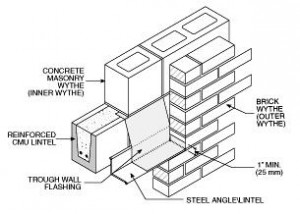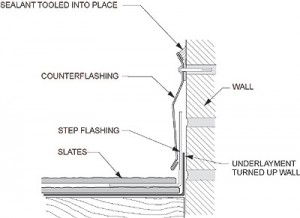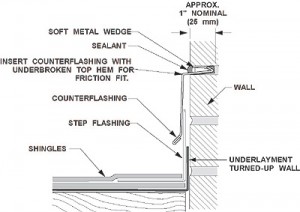Counterflashing, also referred to as “cap” flashing, is the first line of defense against water infiltrating your building. Counterflashing is the piece of metal that is applied to the masonry wall designed to shed water off of the wall and down onto the roof surface. So, it’s critical that you choose the best counterflashing system for your roofing project.
Now, let’s understand counterflashing. In a typical masonry wall application there are three basic types; through-wall counterflashing, reglet counterflashing, and surface-mounted counterflashing.
Through-Wall Counterflashing
 Exactly as titled, this type of flashing extends through the exterior masonry, and ties into the wall cavity. This type of flashing is the best method of protection against moisture and water leaking into your building. However, this method needs to be incorporated into the original construction of your wall, otherwise it’s nearly impossible or very expensive to install as a repair.
Exactly as titled, this type of flashing extends through the exterior masonry, and ties into the wall cavity. This type of flashing is the best method of protection against moisture and water leaking into your building. However, this method needs to be incorporated into the original construction of your wall, otherwise it’s nearly impossible or very expensive to install as a repair.
Surface-Mounted Counterflashing
 This method uses metal cap flashing that is attached to the wall and sealed along the top edge with a bead of caulk. This is the fastest, easiest, and least expensive method of counterflashing. While effective if properly installed, it is also the most likely to fail. Surface-Mounted flashing is heavily reliant on caulk, and requires regular maintenance to ensure the flashing remains in a water tight condition.
This method uses metal cap flashing that is attached to the wall and sealed along the top edge with a bead of caulk. This is the fastest, easiest, and least expensive method of counterflashing. While effective if properly installed, it is also the most likely to fail. Surface-Mounted flashing is heavily reliant on caulk, and requires regular maintenance to ensure the flashing remains in a water tight condition.
Reglet Counterflashing
 When through-wall flashing is not a realistic option, the next best method is to cut a reglet. A reglet is ¾” to 1 ½” deep cut in the masonry. This cut is formed using a grinder or masonry cutting saw. This method allows the installer to insert the counterflashing into the wall. The inserted piece of metal flashing is then packed with lead plugs, and the reglet opening is filled with polyurethane caulk. This additional step of cutting a reglet provides an extra layer of protection against water intrusion, and is typically recommended over surface mounted flashing.
When through-wall flashing is not a realistic option, the next best method is to cut a reglet. A reglet is ¾” to 1 ½” deep cut in the masonry. This cut is formed using a grinder or masonry cutting saw. This method allows the installer to insert the counterflashing into the wall. The inserted piece of metal flashing is then packed with lead plugs, and the reglet opening is filled with polyurethane caulk. This additional step of cutting a reglet provides an extra layer of protection against water intrusion, and is typically recommended over surface mounted flashing.
So, before you finalize your next roofing project, understand the type of flashing you are purchasing. The right flashing system could be the difference between a leaking roof and a watertight roof.


From a client in Baltimore, MD
Factors Most Important In Choosing Fick